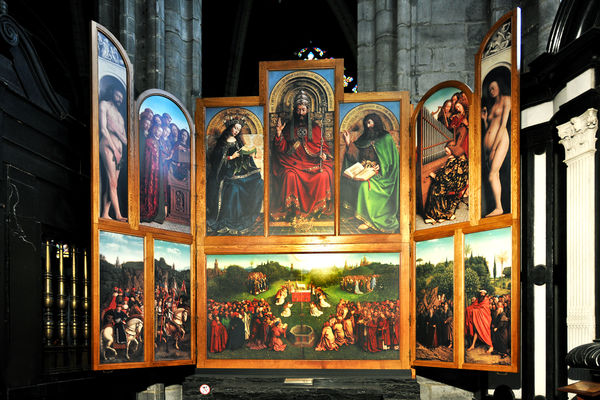A Walk Through Ghent
By Rick Steves

Once one of Belgium's medieval powerhouses, Ghent has hardly been preserved in amber. It's a living urban center, with its share of big-city scruffiness and the vibrant student population you'd expect to find in the home of one of Belgium's biggest universities. But at its heart Ghent still looks much like it did circa 1500, when this was one of Europe's greatest cities: bristling with skyscraping towers, rich with art, and thronged with upscale citizens.
As early as the 1200s, Ghent's population had grown to around 65,000 — north of the Alps, only Paris was larger. Two-thirds of its citizens were textile workers, meaning Ghent was arguably Europe's first industrial city. With its wealth, it became a proud metropolis of the soaring spires visitors still see today.
Ghent is very walkable, and I enjoy strolling through the old town in this extremely Flemish city, where the native language is Dutch (but everyone also speaks English). On a recent visit I started in a square called Korenmarkt (Grain Market), the center of historic Ghent.
Near the square is St. Michael's Bridge, which provides Ghent's best 360-degree panorama. The waterway underfoot — now plied by tourist-laden boats — was the city's busy harbor. Lining the embankment are several ornately decorated guild houses — meeting halls for the town's boatmen, grain traders, and weighers.
From here, I turned around to head away from the river, past a medieval church, toward the big, wooden roof of the market hall. Just a couple decades ago, this space was no more than an ugly parking lot. Now, it's a public square, partially sheltered by the hall's modern twin-gabled roof meant to evoke the rooftops of medieval Ghent. While many residents embrace the market, some find its avant-garde style jarring. (It's been called the "Sheep Shed" and the "Hall of Shame.")
Next door is the Belfry. Although most of this tower has stood here since the 14th century, its Neo-Gothic spire was added when Ghent proudly hosted a World's Fair in 1913. Visitors can ascend the Belfry to share the gargoyles' decent, if not stunning, view over town.
On the other side of the Belfry is St. Bavo's Square and Ghent's top sight: St. Bavo's Cathedral. This towering Gothic church houses the pearl of Flemish painting — the Ghent Altarpiece, also known as the Adoration of the Mystic Lamb. Jan and Hubert van Eyck's work has been called the most influential painting in European art. It's considered the first masterpiece done in oil, and the first to portray the stark realism of the everyday world.
Hubert began the painting, but after his death, his better-known younger brother Jan completed his vision in 1432, taking a colossal stride in Northern European art from medieval stiffness to Renaissance humanism.
The work is monumental: 15 feet wide and 11 feet tall, it's composed of a dozen separate panels depicting hundreds of figures and weighs more than a ton. Its central panel shows pilgrims gathered to honor the Lamb of God (representing Jesus), while other panels depict the Annunciation, Adam and Eve, the Virgin Mary, and John the Baptist. It challenges visitors with its complex symbolism, multitude of rich details, and sheer scale, but it rewards those willing to invest the time to take it all in.
It's astounding that the Ghent Altarpiece has survived for six centuries. It's been the victim of a half-dozen art thefts, making it quite possibly the most stolen painting in existence. Even Hitler claimed it as war booty. In 1934, someone broke into St. Bavo's and stole the Just Judges panel, and, nearly a century later, the panel has yet to turn up. In its place is a top-notch copy, and the theft remains Belgium's greatest unsolved art mystery.
Leaving the church, I walked north till I hit Hoogpoort, the main street of medieval Ghent, and followed it toward the hulking castle across the canal — the Castle of the Counts.
Built in 1180, this rough-stone fortress was designed not to protect the people of Ghent, but to intimidate the city's independence-minded citizens. You get a real feel for the medieval world as you twist through its towers and ramble its ramparts. It has all the parts of a typical castle: courtyard and keep, throne room, chapel, 18-foot-deep dungeon, and high walls. Inside are displays of authentic swords and suits of armor, along with a guillotine that was last used in 1861.
While not "undiscovered" — Ghent is a popular day-trip destination from nearby Brussels and Bruges — it's certainly underrated, and merits a deeper dive. Like sampling a flavorful praline in a Belgian chocolate shop, the first enticing taste you get from this short walk just leaves you wanting more. Go ahead, it's OK — buy a whole box.

